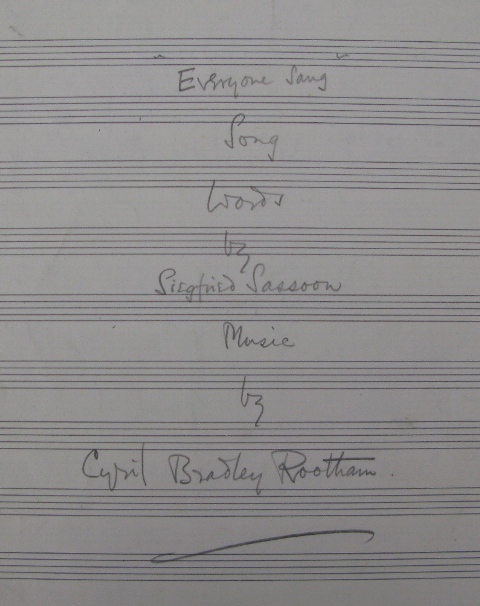Spelling his own name
Siegfried Sassoon matriculated at Cambridge University on 21 October 1905, the centenary of the Battle of Trafalgar and a hundred and five years ago today. The event is recorded in two documents held in the Cambridge University Archives kept here in the University Library: the matriculations register and Sassoon’s student record card. They raise a curious doubt about the spelling of his name.
The generally accepted, ‘correct’ spelling of Sassoon’s middle name is ‘Loraine’, although it’s not uncommon to see it given two ‘r’s, as though the poet had a connection with the region in North-Eastern France. In fact the origin of the name was more parochial, as his biographers explain. Max Egremont writes that it derived from his mother Theresa’s ‘respect for a High Church clergyman, Canon Loraine’, and Jean Moorcroft Wilson adds the detail that it was ‘chosen as a tribute to the clergyman who had advised Hamo [Thornycroft, Sassoon’s uncle] and Theresa when they were organizing her clandestine marriage in January 1884 and who was presumably Siegfried’s godfather.’ John Stuart Roberts says that Loraine had prepared Theresa for confirmation and remained a source of spiritual guidance.
The only Anglican clergyman with the surname of either Loraine or Lorraine in the 1880s was Nevison Loraine, author of The Voice of the Prayer-Book, The Sceptic’s Creed: Can it be Reasonably Held? Is it Worth the Holding?, The Battle of Belief, and other works in a similar vein. From 1872 until his death in 1917 Loraine was Vicar of St Paul’s Church in Chiswick, where Sassoon’s maternal family had connections. He became a canon in 1907, when he was given the Chiswick prebend of St Paul’s Cathedral.
When I first looked at Sassoon’s student record card (in CUA Graduati 32), I noticed immediately that the middle name was ‘misspelt’:
I assumed this was a simple scribal error until I turned to the Matriculation Register (CUA Matr. 19). Unlike on the record cards, which were compiled by clerks, the names in the register are the actual signatures of the students concerned: and Sassoon himself used the spelling ’Lorraine’.
It is unlikely that the names on the record cards were transcribed from the register, so presumably the clerk was working from another source which had the ‘double r’ spelling too. The Admissions Book at Clare College also has ‘Lorraine’, although, like the record card, this is not in Sassoon’s own handwriting. Sassoon seems not to have known how Father Loraine spelt his surname, at least at this period. A copy of Sassoon’s will in MS Add. 9852/5, dating from 1929, uses ‘Loraine’, which shows that his solicitors took care on this point even if the young undergraduate did not.
The matriculation register is also interesting in showing that Siegfried signed ahead of his younger brother Hamo, who matriculated on the same day, also as a member of Clare College. The names in the registers were ordered strictly alphabetically within each college, so Hamo’s signature should have preceded Siegfried’s. Of course mistakes can always happen, as the mix-up between Stirling and Stringer on the same page shows.
Sassoon’s student record card testifies to his lack of progress at Cambridge. His ‘Rank in College’ is shown by the ‘P’, standing for ‘Pensioner’, defined as a student paying fees to his or her college for teaching and for board and lodging. The only information regarding examinations taken comes in the column headed ‘Previous’. The Previous examination, or ‘Little-go’, was a test of knowledge of classical languages and William Paley’s Evidences of Christianity (and for honours candidates, mathematics). Established in the 1820s, the examination was originally sat in an undergraduate’s second year at the University, but by Sassoon’s day it was more commonly tackled in the months preceding a student’s arrival: in Sassoon’s case, the Lent and Easter terms of 1905. In Seven More Years, Sassoon described his time at Henley House, the ‘first-class cramming establishment’ he attended to prepare for the exam, and how he bicycled through the Kentish landscape ‘with bits of Paley disporting themselves in my head.’ The lack of annotation in the right-hand columns of the card, reserved for Tripos (degree exam) results and dates of graduation, is silent testimony to Sassoon’s self-acknowledged inaptitude for academic study.



